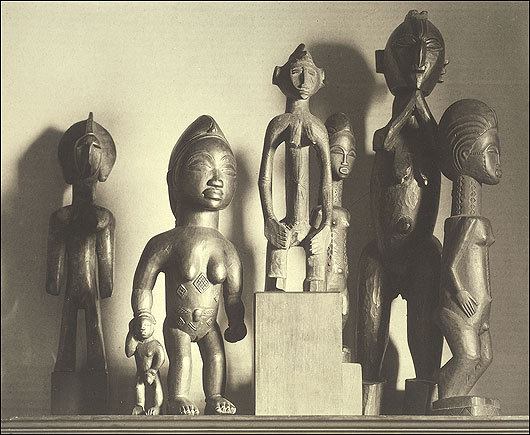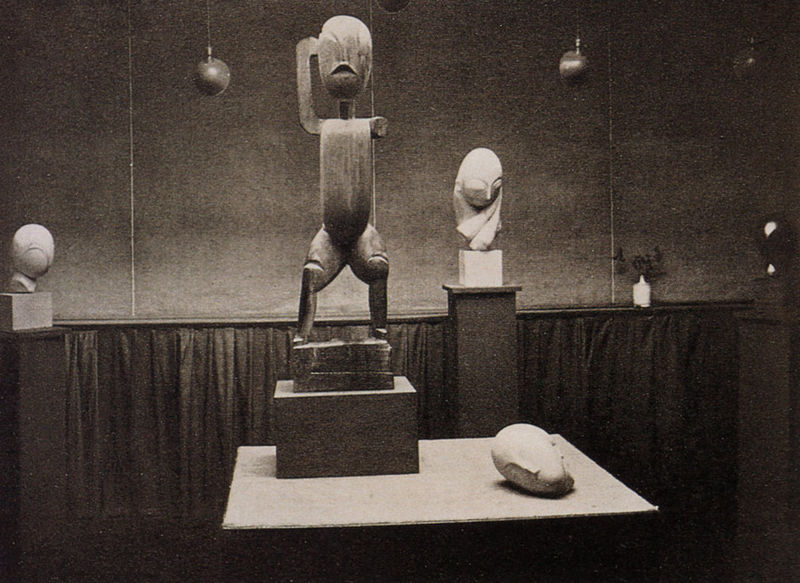Photo Credit Charles Sheeler 1919
…………………………
The appeal of collecting African Art is not a contemporary phenomenon. Colonialists were attracted to tribal art as trophies and for their ethnological interest. As far back as the 15th century, individuals were known to collect these mysterious fetishes and ceremonial objects to satisfy their curiosities.
By the dawn of the 20th century, cultural centers throughout Europe were gearing up for the newest of trends in the art market. It was at this time that these tribal objects began to be regarded for their artistic merit; and hence their stature became elevated as prominent artists of the day, Picasso, Modigliani, Matisse and Brancusi looked to the African genre as a source of inspiration. They began collecting African art and allowed this abstract perspective to shape and create a new art movement.
 A Picasso portrait and an inspirational mask
A Picasso portrait and an inspirational mask
In 1913, a groundbreaking exhibition was staged in New York and the formal introduction of this ethnic body of work was received as a perfect counterpoint to the modern art movement. In fact, it became fashionable to display works by the aforementioned art luminaries with tribal African art. It also became an educational journey to follow the influences of this newly recognized art form with the current European art of the day. Both were introduced to America in tandem at the epic ‘International Exhibition of Modern Art’ commonly referred to as the ‘Armory Show.’
The popularization of the two artistic genres created a unique and dynamic environment in the art market in America, which is still in evidence today.
To aid in acquiring additional information on the subject, I was invited to see a charming and informative exhibition at the Metropolitan Museum of Art in New York, which will run until April 14, 2013. I had the opportunity to receive a private tour of the ‘African Art, New York and the Avant-Garde’ by a friend and colleague, Cole Harrell, himself a young collector of African art. He was immensely informative and shed light on several mysteries about tribal objects and their purposes.
 Cole explained that over the centuries, ritualistic artifacts were plundered by colonialists. It is speculated that the African people began producing pieces for barter and trade to appease a growing interest and demand for their talismans and curiosities – hence causing uncertainty regarding authenticity in the collector’s market in later years.
Cole explained that over the centuries, ritualistic artifacts were plundered by colonialists. It is speculated that the African people began producing pieces for barter and trade to appease a growing interest and demand for their talismans and curiosities – hence causing uncertainty regarding authenticity in the collector’s market in later years.
Here are a few pointers that he shared about acquiring knowledge and embarking on collecting;
“Before you buy a piece, buy this book. ‘The Tribal Arts of Africa’ by Jean-Baptiste Bacquart”
“Pieces come and go, but knowledge is priceless. You have to be willing to do thorough research on the art. Every time you get the opportunity, handle the pieces. Visit galleries and museums. Ask questions. When you’re up front and acquainted with authentic material, you can smell, feel, get a sense for what authenticity looks like.”
As for the individual interested in becoming a true collector, he advises;
“Always buy the best you can afford. Great art is an investment. Under-par pieces only depreciate in value. Become acquainted with noted professionals in the field. More often that not, they’d love to share their knowledge with you.”
.
One in an informative series from High Museum of Art, Atlanta on the subject via YouTube
What to the untrained eye may look crude or haphazard are often in fact intentional nuances that reflect expressive gestures and a silent language. These are the symbols for understanding the artist’s intent with each piece. There is so much that one can actually learn about the cultures of each region through the exploration of their artifacts and art.
One need look beyond the grotesque, phallic, and fearsome presence of these wonderful objects in order to transcend the mysteries of the indigenous peoples of rural Africa, and to discover their dignity and grace. To collect such magnificent things is a privilege and should not be trivialized as mere decorative objects. Their heritage and significance in the history of art, architecture, design and culture is immeasurable.
If you’d like more information, there is an informative BBC documentary on tribal art that is well worth viewing. For the real enthusiast there is also the upcoming NYC Tribal Art Show 2013 – a one of a kind art fair designed for collectors, dealers, curators and museum professionals to view, purchase and discuss traditional art objects from Africa, Oceania and the Americas.

